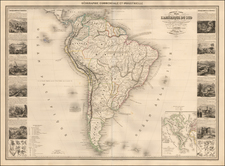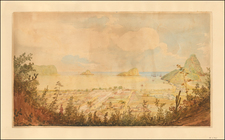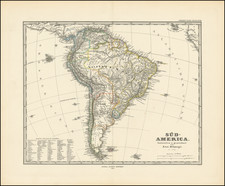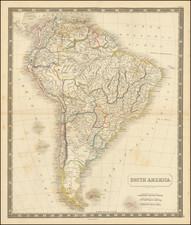Detailed map of South America, published an edition of Geographie Moderne, but without identifying the mapmaker.
Stylistically, the map appears to be from the 1820 period, before the creation of Bolivia and Ecuador:
The struggle for South American independence from Spanish colonial rule was a complex series of events that spanned several decades in the 19th century. It was characterized by the rise of prominent revolutionary leaders, pivotal battles, and the eventual establishment of sovereign nations.
Colombia: The independence movement in Colombia, then part of the Viceroyalty of New Granada, saw its first significant uprising with the revolt of July 20, 1810, which led to the establishment of a junta in Bogotá. This initial push for autonomy was not a definitive break from Spain, but rather a call for self-governance in the absence of a legitimate Spanish king during the Peninsular War in Europe. Full independence was not achieved until a decade later, under the leadership of Simón Bolívar. The pivotal Battle of Boyacá on August 7, 1819, resulted in a decisive victory for the revolutionaries, sealing the fate of the Spanish regime in the region. Following this triumph, the Republic of Gran Colombia was proclaimed on December 17, 1819, encompassing modern-day Colombia, Venezuela, Ecuador, and Panama.
Upper Peru (Bolivia): Upper Peru's struggle was marked by the broader campaigns led by Bolívar and Antonio José de Sucre. After the royalists were defeated in the north, attention turned to Upper Peru. The Battle of Junín on August 6, 1824, and the subsequent Battle of Ayacucho on December 9, 1824, were crucial in undermining Spanish power. Sucre's victory at Ayacucho is often cited as the conclusive end to Spanish military presence in South America. Upper Peru declared its independence on August 6, 1825, establishing the Republic of Bolivia with Sucre as its first president.
United Provinces of La Plata: The May Revolution, which began on May 25, 1810, in Buenos Aires, was a signal event that initiated the independence movement in the United Provinces of La Plata. José de San Martín, who had trained in European military tactics, organized the Army of the Andes and led the remarkable crossing of the Andes mountains, liberating Chile in 1817 with Bernardo O'Higgins and then moving north to liberate Peru. San Martín's meeting with Bolívar at Guayaquil in 1822 was a key moment of unity in the independence cause. However, the region was fraught with internal conflicts that led to the eventual fragmentation into separate entities: Argentina declared independence on July 9, 1816; Uruguay followed after a prolonged struggle, leading to the Treaty of Montevideo in 1828; and Paraguay declared independence on May 14, 1811.
Throughout these events, the influence of Enlightenment ideals, the example of the American and French revolutions, and the power vacuum created by the Napoleonic Wars in Europe catalyzed the movements for independence. The newly independent nations of South America faced significant challenges post-independence, including political instability, border disputes, and economic restructuring. Despite these challenges, the 19th-century independence movements were critical in shaping the political landscape of the continent and fostering a sense of national identity that endures to this day.










![[ Patagonia / Chile / Argentina ] A New Map of the Southern Parts of America taken from Manuscript Maps made in the Country and a Survey of the Eastern Coast made by Order of the King of Spain.](https://storage.googleapis.com/raremaps/img/small/100772.jpg)

![[Portrait of Amerigo Vespucci] America Meridionale . . . 1823](https://storage.googleapis.com/raremaps/img/small/75917.jpg)

